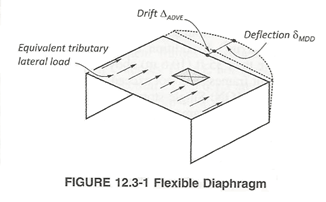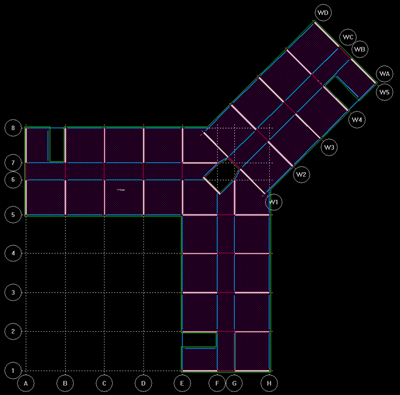Virtuosity Blog
Classifying Semirigid Diaphragms
In previous articles I discussed both Flexible Diaphragms and Rigid Diaphragms. Historically diaphragms have been considered as one of these two types because they accommodated hand calculations and simple analysis in computers with limited resources. Even when the shortcomings of those assumptions were recognized for particular building configurations, computers lacked the speed to perform more robust diaphragm analyses. That is no longer the case, and as a result the Building Codes have taken a more stringent approach to what is permitted in regard to diaphragms, especially for seismic analysis. As I discussed previously, for example, Section 12.3.1 of ASCE 7-16 states:
Classifying Flexible Diaphragms
“Unless a diaphragm can be idealized as either flexible or rigid in accordance with 12.3.1.1, 12.3.1.2, or 12.3.1.3, the structural analysis shall explicitly include consideration of the stiffness of the diaphragm (i.e., semi-rigid modeling assumption).”
ASCE 7-16 Section 12.3.1.1 permits a diaphragm to be considered Flexible when the diaphragm consists of untopped steel decking or wood structural panels in structures where the lateral force resisting system is steel or composite steel braced frames, or concrete, masonry, steel or composite steel shear wall. These are explicitly identified because they are very stiff relative to an untopped steel deck or wood panel floor system. Diaphragms in one- and two-family dwellings, and shttps://blog.virtuosity.com/special-considerations-for-rigid-diaphragmstructures of light-frame construction – with some restrictions – are also permitted to be considered Flexible.
Section 12.3.1.3 further permits any diaphragm to be considered Flexible if the deflection of the diaphragm is greater than two times the drift of the adjacent frames.

Classifying Rigid Diaphragms
Conversely, in Section 12.3.1.2 the only diaphragm condition that is permitted to be considered Rigid is diaphragms of concrete slabs or concrete-filled metal deck with diaphragm span-to-depth ratios of 3 or less in structures that have no horizontal irregularities.
All other diaphragms, according to Section 12.3.1, are required to be considered as Semirigid. This represents a significant portion of structures.
It is interesting to note that IBC 2018 categorizes diaphragms differently. Because IBC 2018 references ASCE 7-16 with no changes to the definition of Flexible diaphragm, the requirement of Section 12.3.1.3 of ASCE 7-16 applies, in which a diaphragm can be considered to be Flexible if the lateral deflection of the diaphragm is greater than two times the drift of the adjacent frames. But then in Section 1604.4 of IBC 2018 the definition of Rigid diaphragm is modified from that found in ASCE 7:
“A diaphragm is rigid … when the lateral deformation of the diaphragm is less than or equal to two times the average story drift.”
Characteristics of Semirigid Diaphragm
Hence, per the IBC, all diaphragms can be considered as either Flexible or Rigid. Simply put, categorize the diaphragm by comparing diaphragm deflection to frame deflections: if that ratio is more than two, the diaphragm can be analyzed as flexible; if that ratio is less than or equal to two, the diaphragm can be analyzed as rigid. I don’t recommend this, however; I believe that the ASCE 7 definition is generally more appropriate. It may also be more practical to analyze the diaphragms as semirigid since such an analysis would be required anyway to perform the deflection calculations necessary to classify the diaphragms as one or the other. It is permissible in any case to model and analyze the diaphragm as semirigid.
As I indicated above, Section 12.3.1.2 of ASCE 7 does not allow diaphragms of structures with horizontal irregularities to be analyzed as Rigid. This is due to the fact that diaphragms in such structures may play a larger role in the behavior of the structure and in the distribution of the forces to the lateral force resisting system. The diaphragms may play a larger role in mitigating the potential damage to the structure due to the irregularities. In such cases it is important to know the forces in and displacements of the diaphragm so that it can be properly designed. Furthermore, structural irregularities are often localized conditions, so it is important that the local impacts of the diaphragm flexibility are considered in the analysis. For example, unless there is a horizontal floor truss, when there is a Horizontal Offset Irregularity the diaphragm is the mechanism for distributing the lateral forces out of the frame above over to the frame below. A torsional irregularity is evidence of a poor distribution of frames and frame stiffness, or of a highly uneven distribution of diaphragm masses; this is likely to place more demand on the diaphragm, and requires a more accurate consideration of how the diaphragm is interacting with the frames. Similarly, frames in nonparallel systems have a much higher degree of interaction than orthogonal frames, and are tied together to the degree that the diaphragm is capable.

n a building with multiple wings the floor may consist of a very stiff concrete slab; despite that, a rigid diaphragm analysis would probably not be appropriate. In a rigid diaphragm analysis, the far ends of the wings would be constrained to translate and rotate together. A semirigid diaphragm analysis would more correctly allow those wings to displace independently of each other, tied together only by the stiffness of the diaphragm where the wings meet at the core.
A diaphragm with large openings would obviously not behave the same as a solid diaphragm.
And a long, narrow diaphragm could be rigid in one direction but not in the other.
Although historically the influence of diaphragms was given lesser consideration, and simplified approximated methods were allowed due to the need to use more simple hand and analytical techniques, increasingly the structures designed and built today need more robust analysis. Incorporation of semirigid diaphragms in the analysis is part of that. In the next article I will discuss Characteristics and Modeling of Semirigid Diaphragms.

